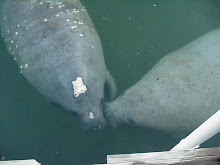I like, no, love visiting historical (and interesting) places as those of you who regularly read my blog can attest to.
So, when The Colonel asked me if I wanted to visit and take a tour of the Jack Daniels Distillery or see the birthplace and a boyhood home of Abraham Lincoln on our trip back home from Indiana to Florida, after my dad's funeral, there could be only one answer to his question.
I'll take Abe over Jack for $800 Alex.
Abraham Lincoln was born in Hodgenville, Kentucky on February 12, 1809. The little, one-room, log cabin he was born in was located on the 300-acre Sinking Spring Farm.
The spring that gave the farm its name is still there. The Colonel and I walked down the steps approaching the spring.
It was much cooler, almost like an air conditioner was running, the closer you got to the spring. It felt lovely, as it was hot and humid in Hodgenville that day.
I liked seeing the spring where our beloved 16th President of the United States got his first drinks of cool water.
The Lincoln National Birthplace Memorial (built in 1909) houses a symbolic log cabin that is seated upon the original site of the Lincoln cabin. The cabin is symbolic because the Lincoln cabin is no longer in existence (dismantled sometime before 1865). It is smaller than the Lincoln cabin was; it had to be built smaller (12 x 17) to fit inside the memorial building. The Lincoln cabin would have looked like the symbolic cabin but larger (16 x 18).
The Colonel and I walked the 56 granite steps (one step for each year of Lincoln's life) up to the memorial building.
We saw the corner stone of the memorial that was placed by President Theodore Roosevelt on February 12, 1909 on the 100th anniversary of Lincoln's birth. The memorial building was designed by John Russell Pope who also designed the Jefferson Memorial in Washington, D.C.
The inside of the memorial building was nice and cool. The one-room, log cabin nearly filled the entire building. The gray flooring behind the chained off area marks the original size of the Lincoln cabin.
I was in historical heaven. I wanted so much to be able to go inside the cabin but standing very near the place where Abraham Lincoln drew his first breath filled me with such bliss. That alone would have to suffice.
Abraham Lincoln lived at Sinking Spring Farm until he was about 2 1/2 years old.
In 1811 the Lincoln's moved to a farm on Knob Creek, about 10 miles to the northeast. Guess where we headed next?
The Lincolns lived on the Knob Creek farm until 1816 and Abraham's first childhood recollections are from this boyhood home.
This is the log cabin on the Knob Creek farm. It is the Gollaher family cabin and it was built in 1800. The Gollahers were friends and neighbors of the Lincolns and lived in this cabin on a nearby farm. The cabin was moved to Knob Creek from its original location much later and refurbished. The Lincoln's cabin would have been very much like the Gollaher's.
In his 1860 campaign autobiography, Abraham Lincoln wrote, "I was born February 12, 1809, in Hardin County, Kentucky. My earliest recollections, however is of the Knob Creek place."
Lincoln told of events from his boyhood years spent in the beautiful farm valley. Some memories stood out more than others like the time he recalled planting pumpkin seeds in the fields only to see them washed away by a flash flood. He said, "One time the rain from the hills came down and washed corn and pumpkin seeds clear off the field."
He also recalled the time he fell into Knob Creek and nearly died. The water was high because of recent rains. He and his good friend Austin Gollaher were hunting for wild partridge. Seven-year-old Abe wanted to cross the swollen creek on a log footbridge. He lost his footing and fell into the creek. He could not swim and began to thrash around. Austin looked around and found a long sycamore limb and held it out for Abe to grab hold, but Abe nearly drowned before Austin could pull him to safety. The boys promised to keep this experience a secret to avoid a spanking from their parents. Years later Austin told the story many times.
Above, you see my feet at the water's edge of Knob Creek. The water was quite a bit lower (nearly non-existent) than it was on the day Abe Lincoln nearly drowned in 1816. Again, I was in historical heaven. I was traipsing in and alongside the same creek Abe Lincoln did as a child.
I had just seen and experienced the birthplace and Kentucky boyhood home of young Abe Lincoln: his beginning. I saw and experienced the place of his ending too but it appears that I had gone about the chronology of Abe's life, backasswards.
In October 1986 The Colonel and I were married and we spent our honeymoon in Washington, D.C. We did many of the things tourist do while they are in D.C. (we also had the most delicious Kung Pao Chicken by which standard I still hold all others up to and have yet to find one as delicious).
We visited Ford's Theater and saw the Presidential Box where President and Mrs. Lincoln were sitting when Lincoln was shot.
On the evening of April 14, 1865 the Lincoln's were enjoying the play, Our American Cousin at Ford's Theater. Lincoln's bodyguard, John Parker, left the theater during intermission to join Lincoln's coachman for drinks at the Star Saloon next door. President Lincoln was now unguarded.
At around 10:13 pm, John Wilkes Booth snuck up behind President Lincoln, aimed at the back of his head and fired at point-blank range, mortally wounding the President.
An Army surgeon, Dr. Charles Leale was sitting nearby at the theater and began to immediately assist the President. Abraham Lincoln was unresponsive, barely breathing and with no detectable pulse.
The Dr. having determined that Lincoln was shot in the head and not stabbed in the shoulder as previously thought, made an attempt to clear the blood clot, after which the President began to breathe more naturally.
The dying President was carried across the street to the Petersen House.
The Colonel and I retraced the footsteps of those carrying the President that night in 1865. We went to the Petersen House too. We entered the room that President Lincoln was taken to.
We stood next to the bed that Lincoln was laid upon and saw the bloodstained pillow his head rested on as he lay dying.
President Abraham Lincoln was in a coma for nine hours before he took his last breath and died at 7:22 am on April 15, 1865.
I had been where President Lincoln breathed his first and last breaths; his beginning and his end.
"Now he belongs to the ages." - Secretary of War, Edwin M. Stanton, April 15, 1865





















































No comments:
Post a Comment